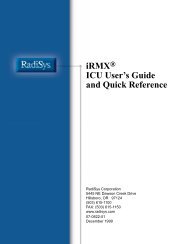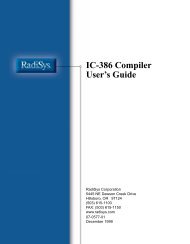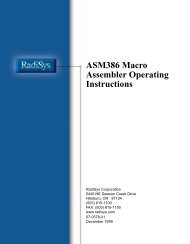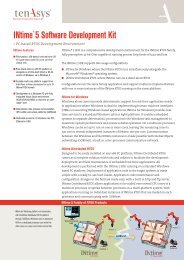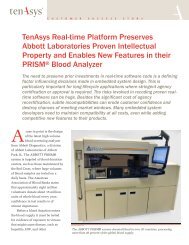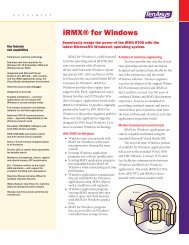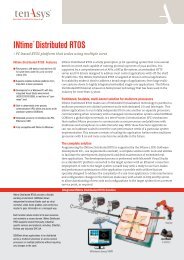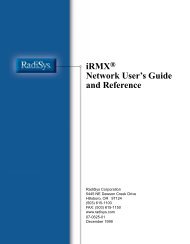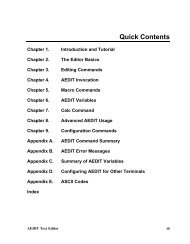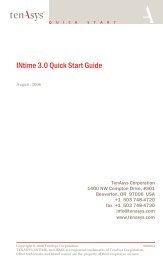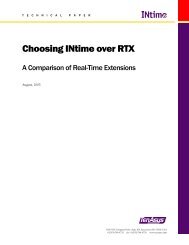INtime® 3.1 Software - tenAsys
INtime® 3.1 Software - tenAsys
INtime® 3.1 Software - tenAsys
Create successful ePaper yourself
Turn your PDF publications into a flip-book with our unique Google optimized e-Paper software.
Glossary<br />
memory area<br />
memory pool<br />
message port<br />
multiprogramming<br />
multithreading<br />
object<br />
object directory<br />
OSEM<br />
PIC<br />
priority-based<br />
scheduling<br />
priority inversion<br />
process<br />
region<br />
Provides memory for threads to use for many purposes, including communicating<br />
and storing data.<br />
An amount of memory, with a specified minimum and maximum, allocated to a<br />
process. The basis of INtime software’s memory management. The initial memory<br />
pool is all the memory available to the application (that is, free space memory). It is<br />
managed by the OS and allocated to the application on request.<br />
An RT kernel object type managed by the kernel. Used to provide an access point for<br />
an INtime application thread to communicate with an INtime service.<br />
Ability of an operating system to simultaneously run several unrelated applications<br />
on a single system. Allows more than one application to run at a time.<br />
Ability of an operating system to run multiple threads at virtually the same time.<br />
When the operating system stops executing one thread, it resumes/starts executing<br />
another thread. This transition from one thread to another is called a thread switch.<br />
An instance of a data structure that can be accessed only through a set of functions<br />
provided by a type manager.<br />
A storage area within an INtime process where objects can be cataloged, i.e. have a<br />
name associated with the objects so that other theads may refer to/access the<br />
cataloged object by name.<br />
(OS Encapsulaton Mechanism) Manages the simultaneous operation and integrity of<br />
the Windows kernel and the RT kernel. Used only with INtime nodes.<br />
(Programmable Interrupt Controller) An integrated circuit that can resolve<br />
simultaneous interrupt requests and negotiate a sequence of CPU interrupt requests<br />
based on the priorities of the requesting device controllers.<br />
Abiltiy of an operating system to assign execution order importance values (priority)<br />
to each thread in the system. In an INtime system, the scheduling policy enforced by<br />
the INtime kernel is that the highest priority ready thread is/will immediately become<br />
the running thread. Thus, when thread A is running, if thread B becomes ready<br />
through some system event, and thread B is higher priority than thread A, then the<br />
INtime kernel will immediately preempt thread A, and make thread B the running<br />
thread.<br />
A situation in which a high-priority thread is effectively prevented from running by<br />
a lower-priority thread. Proper use of the RT kernel’s region objects eliminates this<br />
problem.<br />
An RT kernel object type. Processes have memory pools and contain/own execution<br />
threads and other objects.<br />
An RT kernel object type managed by the kernel. Regions are binary semaphores with<br />
special suspension, deletion, and priority-adjustment features. You can use regions to<br />
provide mutual exclusion for resources or data.<br />
187



